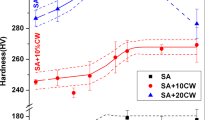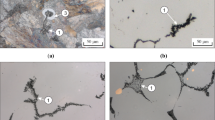The effect of copper content in the range of 0.8–1.4% on mechanical properties and cold resistance of low-alloy precipitation-hardening steel for fittings after heat treatment is investigated. It is established that steel containing 1.4% copper provides the maximum level of strength properties after normalizing and tempering and in this case the steel has an acceptable level of impact strength and cold resistance. The microstructure of steel with 1.4% Cu is investigated by scanning and transmission electron microscopy after tempering at different temperatures. Structure formation in steel with a high copper content during heat treatment by regimes simulating fitting preparation by hot stamping with subsequent tempering, including changes occurring with a secondary structural component, carbonitride particles, and copper particle strengthening precipitates, is studied in detail.







Similar content being viewed by others
References
C. S. Smith and E. W. Palmer, The Precipitation Hardening of Copper Steels, New York Meeting, February (1933).
S. R. Goodman, S. S. Brenner, and J. R. Low, “An FIM-atom probe study of the precipitation of copper from iron-1.4 at.% copper,” Metallurgical Transactions, 4, 2363–2378 (1973).
A. Deschamps, M. Militzer, and W. J. Poole, “Precipitation kinetics and strengthening of a Fe–0.8wt% Cu alloy,” ISIJ Int., 41, No. 2, 196–205 (2001).
Takashi et al., “Effect of thermo-mechanical processing on mechanical properties of copper bearing age hardenable steel plates,” Transactions ISIJ, 27, 478–484 (1987).
Tomita Yukio et al., “Development of 590 MPa class high tensile strength steel with superior HAZ toughness by copper precipitation hardening,” ISIJ Int., 34, No. 10, 836–842 (1994).
S. Takaki, M. Fujioka, Sh. Aihara, Ya. Nagataki, T. Yamashita, N. Sano, Yo. Adachi, M. Nomura, and H. Yaguchi, “Effect of copper on tensile properties and grain-refinement of steel and its relation to precipitation behavior,” Mater. Trans., 45, No. 7, 2239–2244 (2004).
M. K. Banerjee, D. Ghosh, and S. Datta, “Effect of composition and thermomechanical processing on the ageing characteristic of copper bearing HSLA steel,” Scandinavian J. of Metallurgy, 29, 213–223 (2000).
M. Yu. Matrosov, P. G. Martynov, A. A. Kichkina, O. P. Talanov, A. M. Korchagin, O. N. Sychev, and V. V. Mikheev, “Development of low-carbon precipitation-hardening steel alloyed with copper for connecting components of main gas pipelines (fittings) of strength classes K60-K65 prepared by hot stamping,” Metallurg, No. 4, 64–71 (2016).
D. Coutsouradis, V. Leroy, T. Greday, and J. Lecomte-Beckers, “Review of hot shortness problems in copper containing steels. Paper from the Proceedings of the Copper in Steel Conference, Luxembourg,” ATB Metallurgy, 23, No. 3, 7.1–7.24 (1983).
N. Imai, N. Komatsubara, and N. Kunishige, “Effect of Cu and Ni on hot workability of hot-rolled mild steel,” ISIJ Int., 37, 224–23 (1997).
A. Takemura, Yu. Ugawa, K. Kunishige, Ya. Tanaka, Sh. Hashimoto, and K. Ootsuka, “Surface hot shortness of copper containing steel in a compact strip production,” Process Mater. Trans., 52, No. 10, 1905–1911 (2011).
A. A. Kholodnyi, M. Yu. Matrosov, P. G. Martynov, et al., “Effect of heating for hot stamping and tempering on the structure and properties of low-carbon copper-containing steels for high-strength fittings manufactured without hardening,” Probl. Chern. Met. Materialoved., No. 4, 86–93 (2020).
F. B. Pickering, Physical Metallurgy and Steel Development [Russian translation] Metallurgiya, Moscow (1982).
R. Monzen and M. Iguchi, “Structural changes of 9R copper precipitates in an aged Fe–Cu alloy,” Philosophical Magazine Letters, 80, No. 3, 137–148 (2000).
Author information
Authors and Affiliations
Corresponding author
Additional information
Translated from Metallurg, Vol. 65, No. 12, pp. 32–38, December, 2021. Russian DOI: https://doi.org/10.52351/00260827_2021_12_32.
Rights and permissions
About this article
Cite this article
Matrosov, M.Y., Kholodnyi, A.A., D’yakonov, D.L. et al. Effect of Copper Content and Heat Treatment Schedules on Mechanical Properties, Cold Resistance, and Microstructural Constituent Morphology in Precipitation-Hardened Steel. Metallurgist 65, 1381–1390 (2022). https://doi.org/10.1007/s11015-022-01285-3
Received:
Published:
Issue Date:
DOI: https://doi.org/10.1007/s11015-022-01285-3




